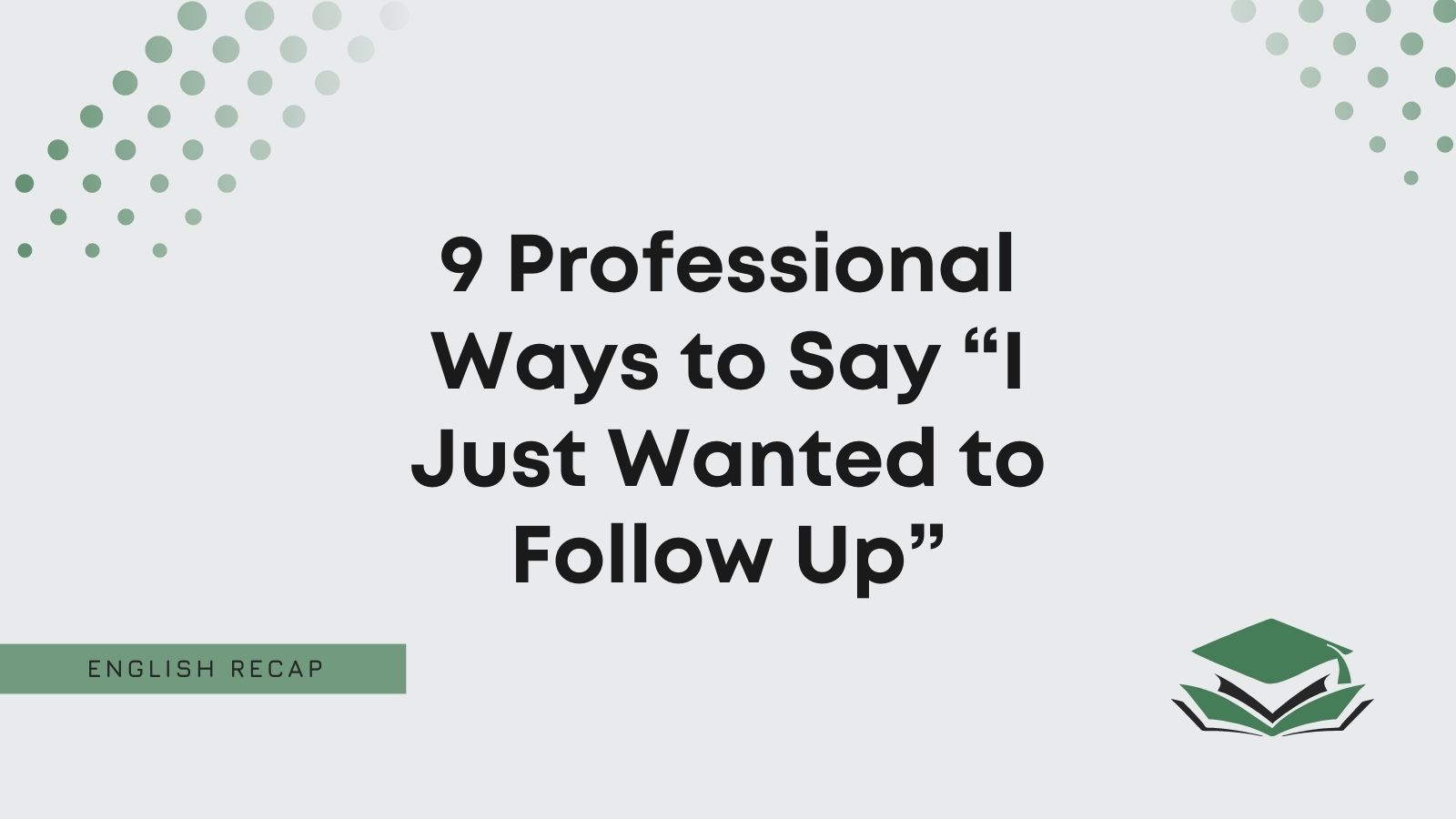It’s always worth sending a follow-up email after a meeting or business proposal. However, you need to know the best phrase to use to be polite and professional.
In this article, we will explore how to write a follow-up email without saying “I just wanted to follow up.”
Is It Professional to Say “I Just Wanted to Follow Up”?
It is not professional to say “I just wanted to follow up.” It’s a bit too informal in its delivery, so it won’t work very well in most business contexts.
You should write a follow-up email, but you’d be much better off using a different phrase.
With that said, you can refer to this example to see how this phrase works conversationally:
I just wanted to follow up to see what you made of the proposal.
Pros
- It’s polite and friendly.
- It works well as a conversational phrase.
Cons
- It’s not a professional option.
- Including “just” makes it seem a bit insincere.
“I just wanted to follow up” has its uses, but it’s not great in professional settings. So, it’s worth exploring some alternatives to see what else is available.
Keep reading to find another way to say “I just wanted to follow up.” We’ve provided an example for each one to show you how it works.
What to Say Instead of “I Just Wanted to Follow Up”
- Further to my previous email
- I would like to follow up
- I’m writing to follow up
- As a follow-up
- Further to what I said before
- Continuing from our previous discussion
- Continuing from my previous email
- Just checking in
- Just a quick follow-up
1. Further to My Previous Email
Another way to say “I just wanted to follow up” is “further to my previous email.” It’s a great one if you want to politely follow up with someone who hasn’t replied to you. Generally, it shows that you respect the recipient, but you also expect a reply.
We recommend using this when emailing potential employers. It shows that you’re keen to hear an update about your application, but they may not have gotten around to sending you more information yet.
This follow-up email example will help you with it:
Dear Craig,
Further to my previous email, did you find out the status of my application? I’m keen to hear back from you.
All the best,
Jean Grey
2. I Would Like to Follow Up
If you want to know how to write a follow-up email after no response, try “I would like to follow up.” It is polite and clear, and it shows that you expected a response from someone sooner.
Of course, there are plenty of reasons why someone might not have been able to reply to you. That’s why it helps to be as polite as possible when asking them for a reply if they forget to do so.
You can use this when emailing clients about important information. It shows that you expected a response sooner, but you’re happy to send a follow-up email and wait for one.
Check out this email sample to see how it works:
Dear Mr. Kingston,
I would like to follow up with you on the email below this one. Have you got an answer for me yet?
Best wishes,
Dan Tate
3. I’m Writing to Follow Up
A good way to politely ask for a follow-up in a formal email is “I’m writing to follow up.” You can always start an email with “I’m writing to.” It shows that you have an intention and purpose behind whatever you write next.
Generally, this works best to email employees after a meeting. It shows you would like to hear more about their views on the meeting and would like to follow up to learn what they thought about it.
Here’s a great follow-up email example to help you:
Dear Julie,
I’m writing to follow up on our conversation about the meeting. I have attached a file in my previous email that I’d like you to review.
Kind regards,
Adam Lambert
4. As a Follow-Up
A simple alternative to “I just wanted to follow up” is “as a follow-up.” It’s easy to understand and suggests that you’d like to hear back when someone doesn’t respond straight away.
It’s not rude, and you can use it to show that you’d like to continue a discussion. We recommend using it after a few days have passed and you haven’t heard back from someone.
The following example will help you if you’re still not sure:
Dear Sarah,
As a follow-up with you regarding our previous correspondence, did you find out what caused the problems with the task?
Kind regards,
Kim Walters
5. Further to What I Said Before
“Further to what I said before” shows you how to write a follow-up email after an interview. It shows that you’ve already asked about your interview status but may not have heard back from someone.
You can email an employer again if sufficient time has passed since you last checked in with them. It’s always good to try this since it shows you’re really keen on the job and would like to know where you stand.
Here’s a great sample email to show you how it works:
Dear Mr. Clarke,
Further to what I said before, have you got an update on my interview status? I’m keen to hear back from you.
All the best,
Janet Peters
6. Continuing From Our Previous Discussion
“Continuing from our previous discussion” is a great alternative to “I just wanted to follow up.” It works well in many contexts because it suggests that you have previously spoken to someone about an issue.
For example, let’s say you emailed a contact about your job application. Perhaps they will find out before you whether you were successful and you’ve already spoken about it.
It’s wise to use “continuing from our previous discussion” to let them know you’re keen to hear about your application status. It works well in most professional email contexts.
Check out this email sample as well:
Dear Michael,
Continuing from our previous discussion, have you received any news on my application yet?
Thank you,
Chris Walken
7. Continuing From My Previous Email
Let’s assume you want to pick up where you left off in a conversation. That’s great, as it shows you’re keen to keep things rolling and keep the ideas coming. It’s especially effective if you’re discussing a new work project with colleagues.
However, if your colleague hasn’t yet replied, you may need to remind them. That’s where “continuing from my previous email” comes in. It shows you’re keen to connect with your colleague again, especially if it’s relevant to something you’ve spoken about previously.
You can also refer to this follow-up email example:
Dear Bethany,
Continuing from my previous email, have you got any news for me? I’m keen to see if you have any updates.
Yours,
Duncan Bannatyne
8. Just Checking In
You can follow up on a proposal with “just checking in.” However, you should ensure that it’s a casual situation. It’s certainly not the most formal option when replacing “I just wanted to follow up.”
We still recommend using it when emailing coworkers. Though, you should only use it when you haven’t heard back from coworkers with whom you have a good relationship.
Otherwise, the tone of “just checking in” might not come across as appropriate. If you’re asking for someone you don’t know well to respond to a previous email with “just checking in,” it might make the content of the email seem uninteresting or irrelevant.
Here’s a great example to explain more about it:
Hey Henry,
Just checking in with you since I haven’t heard back from you in regard to our previous discussion.
All the best,
Peter Schmit
9. Just a Quick Follow-Up
We also recommend using “just a quick follow-up” as a casual synonym for “I just wanted to follow up.” Using words like “just” and “quick” removes the phrase’s formality. It’s still polite, but you should only use it when emailing friends.
So, use it to email customers you get along well with. It shows you have a good relationship with them and you would like to follow up on a previous email or discussion. Perhaps you want to find out if they still agree with you on something before moving on.
Here’s a useful example to show you how it works:
Hi Howard,
Just a quick follow-up with you regarding the position. Have you thought any more about my offer?
Kind regards,
Jackson Pollock

